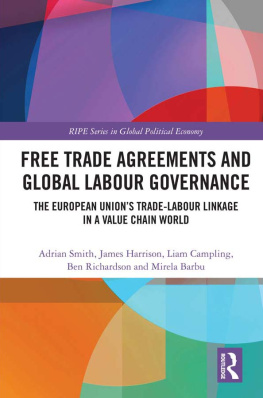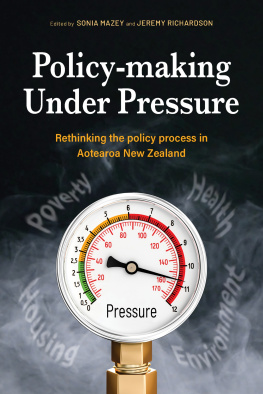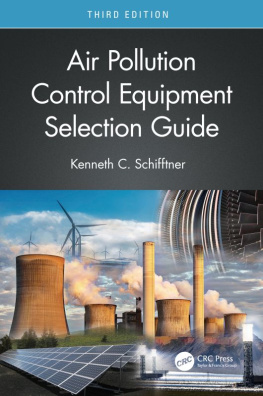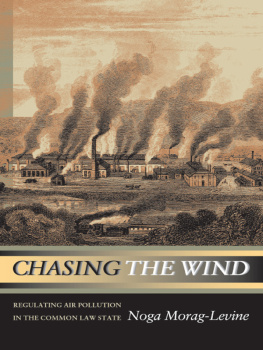INTEGRATED POLLUTION CONTROL
Integrated Pollution Control
Change and Continuity in the UK Industrial Pollution Policy Network
ADRIAN SMITH
First published 1997 by Ashgate Publishing
Reissued 2018 by Routledge
2 Park Square, Milton Park, Abingdon, Oxon, OX14 4RN
711 Third Avenue, New York, NY 10017, USA
Routledge is an imprint of the Taylor & Francis Group, an informa business
Copyright Adrian Smith 1997
All rights reserved. No part of this book may be reprinted or reproduced or utilised in any form or by any electronic, mechanical, or other means, now known or hereafter invented, including photocopying and recording, or in any information storage or retrieval system, without permission in writing from the publishers.
Notice:
Product or corporate names may be trademarks or registered trademarks, and are used only for identification and explanation without intent to infringe.
Publishers Note
The publisher has gone to great lengths to ensure the quality of this reprint but points out that some imperfections in the original copies may be apparent.
Disclaimer
The publisher has made every effort to trace copyright holders and welcomes correspondence from those they have been unable to contact.
A Library of Congress record exists under LC control number: 96079947
ISBN 13: 978-1-138-31734-5 (hbk)
ISBN 13: 978-0-429-45382-3 (ebk)
Contents
The introduction of the Integrated Pollution Control system was to have been one of the most radical innovations in UK environmental policy for a generation. The 1990 Environmental Protection Act brought changes in both the regulatory principles underlying industrial pollution control and the institutional means for applying them.
The goals were ambitious: to sweep away parallel regulatory systems and bring complex industrial processes under the control of a single regulator; to regulate discharges to different environmental media within the same framework so as to achieve the best solution for the environment as a whole; and to make the UKs system more compatible with the evolving style of European Union environmental policy. The motives for instituting this change were complex and apparently contradictory in some respects. The need for change was recognised by all interested parties, including business, environmental groups and government itself. One goal was to provide the means to implement a more ambitious environmental policy. Another, ironically, was to pursue a deregulatory agenda by providing a regulatory one stop shop and cutting the red-tape involved in securing the authorisation for industrial processes. The motive was to make it easier to implement European initiatives, yet it would preserve the distinctive style of British regulation.
This book makes it clear, as in many other areas of public life, that policy was for all practical purposes made as it was implemented. The institutional and technological complexities of applying abstract regulatory principles posed immense challenges. These challenges were most easily met by those who had the necessary technical expertise and who were closest to implementation on the ground - that is industry itself and the staff of HM Inspectorate of Pollution (HMIP). Understaffed and overwhelmed by the task of bringing thousands of processes within the new system over a four year period, HMIP inevitably had to rely very much on the co-operation of industry. Inevitably, the traditional style of UK pollution control began to re-emerge. Decisions were based on case-by-case pragmatism rather than the application of generic principles and standard rules; the discretion of individual site inspectors began to play a more important role; and the process of decision-making became less transparent to external observers.
Electricity generation and chemicals manufacture engendered particularly high levels of controversy during the implementation of Integrated Pollution Control. While the power sector debate related to the context of privatisation and the specific nature of background European legislation, the chemical industry controversies raised more generic issues. Indeed the traditional British pragmatism which re-emerged can be attributed almost directly to the experience of authorising organic chemicals processes.
That experience is the subject of this book. The book makes two distinct contributions. First, it provides an authoritative account of how UK Integrated Pollution Control came about and how it was implemented. By using organic chemicals as the case study, the author is able to highlight the key debates which underpinned the implementation process. Through interviews with all of the key players and through detailed examination of the documentation that greater openness has allowed into the public domain, the author is able to analyse in detail the ebb and flow of the debates which have characterised the Integrated Pollution Control policy initiative.
Secondly, the book provides a useful addition to the literature on policy networks theory. The case study provides powerful evidence that the membership of networks and the relationships between actors can be of critical importance in determining policy outcomes. In this case, a very tight network consisting of industry and regulators put in place a system of pollution control which is rather different from that envisaged by the original architects.
To that extent, the book is invaluable. But the debate about the style of industrial pollution control is not yet over. The European Unions new framework Directive on Integrated Pollution Prevention and Control leans heavily on the UK system of Integrated Pollution Control - or at least the system as originally conceived. A new set of policy issues will arise as the Directive is given effect in individual Member States and more specific daughter Directives are developed. This process could follow the British route - aspiring to pollution prevention through pragmatic assessment on a case-by-case basis - or the alternative approach of specifying process requirements in ever more detail. Implementation will be at least as complex as that of IPC in the UK.
This is the final contribution of the book. The analysis of the implementation process for Integrated Pollution Control in the UK provides very obvious clues about the issues and debates that will arise as future measures are proposed and implemented. Implementation and policy network concepts will prove just as relevant and useful then as they have done in this book.
Professor Jim Skea
Director
ESRC Global Environmental Change Programme
As the title suggests, this book is not so much concerned with the science of pollution, nor with the technologies for controlling it, but rather with the social and political processes by which levels of pollution are established. In particular, this book examines how industrial pollution is regulated in the UK.
There are over 100,000 industrial chemicals in commercial use worldwide. Another 500 to 1,000 new chemicals are added to that list each year. The US National Academy of Science has written that toxicity information for a majority of these chemicals is absent, whilst for the remainder it is minimal. Indeed, there are serious gaps and uncertainties (perhaps chaotically inherent) in our knowledge of the effects of industrial chemicals on ecosystems.











